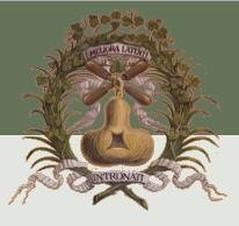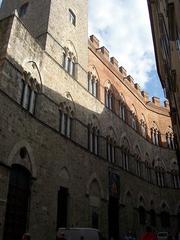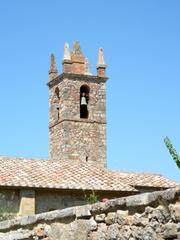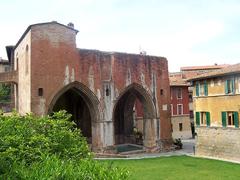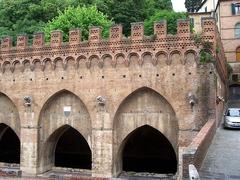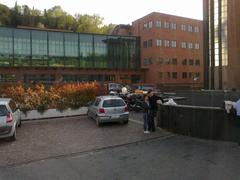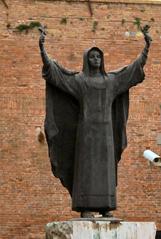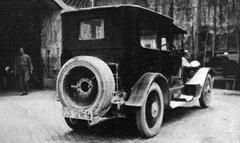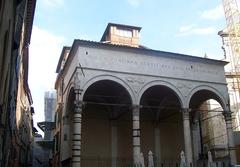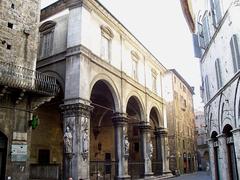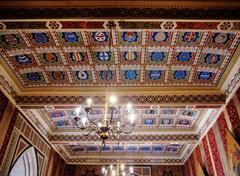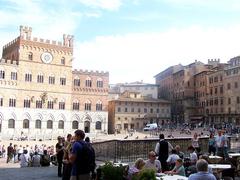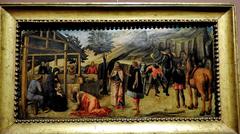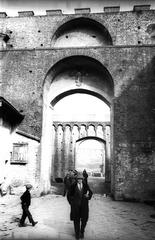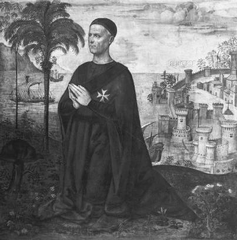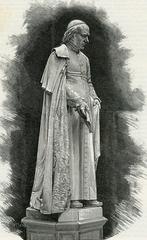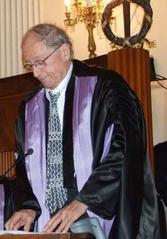Museum of the Noble Contrada of the Bruco, Siena: Visiting Hours, Tickets, and Complete Guide
Date: 14/06/2025
Introduction
The Museum of the Noble Contrada of the Bruco, located in the heart of Siena, Italy, offers an immersive journey into the city’s medieval past, living traditions, and the unique culture of one of Siena’s most historic neighborhoods. As one of the city’s 17 contrade—distinct districts that form the backbone of Sienese social life—the Contrada del Bruco (“District of the Caterpillar”) distinguishes itself through its noble status, revolutionary history, and vibrant participation in the Palio di Siena horse race. The museum houses an exceptional collection of Palio banners, ceremonial costumes, religious artifacts, and archival documents, providing visitors with a rare window into the enduring spirit and community life of the Bruco.
This comprehensive guide covers everything you need to know for a memorable visit: the museum’s historical context, highlights of its collections, visiting hours, ticketing details, accessibility, practical tips, and answers to frequently asked questions. Whether you are a history buff, a culture seeker, or simply curious about Siena’s traditions, the Museum of the Noble Contrada of the Bruco is an essential stop on your itinerary. For up-to-date information, see the Contrada’s official website, the Palio Siena portal, and Visit Siena Official.
Table of Contents
- Discovering the Contrada del Bruco: Siena’s Historic Gem
- Historical Background and Noble Status
- Symbols, Traditions, and Community Life
- The Bruco and the Palio di Siena
- Museum Highlights: Collections and Exhibits
- Visiting Hours, Tickets, and Accessibility
- Practical Tips & Nearby Attractions
- Frequently Asked Questions
- Summary and Recommendations
- Sources and Further Reading
Discovering the Contrada del Bruco: Siena’s Historic Gem
The Contrada del Bruco is renowned both for its revolutionary legacy and for the rich traditions it upholds. Its headquarters and museum are located at Via del Comune, 44, in the Terzo di Camollia district, just a short walk from Siena’s iconic Piazza del Campo. The Bruco’s name (“Caterpillar”) and emblem—a crowned green caterpillar crawling on a rose—harken back to its roots in the silk trade, symbolizing industriousness, transformation, and resilience.
The Contrada is not only a historical entity but also a vibrant civic association, organizing events, charitable work, and social gatherings for all ages. This living tradition is most spectacularly displayed during the Palio di Siena, but it infuses daily life year-round (siena-guide.com, terredisiena.it).
Historical Background and Noble Status
Originating in the Middle Ages as a military district, the Contrada del Bruco was responsible for the city’s defense and local governance. Its reputation for valor culminated in 1369, when it helped defeat the Holy Roman Emperor Charles IV’s forces at the Croce del Travaglio. This act of bravery earned the contrada the prestigious title “Nobile” (Noble), one of only four contrade so honored (ilpalio.siena.it).
Just two years later, in 1371, the Bruco’s members—led by the legendary Francesco d’Agnolo (“Barbicone”)—staged a historic uprising, toppling Siena’s ruling Government of the Twelve and establishing the “Monte del Popolo,” a government by the people. This revolutionary spirit remains central to the Bruco’s identity, encapsulated in its motto: “Come rivoluzion suona il mio nome” (“As revolution sounds my name”). These episodes are commemorated in the museum’s artifacts and storytelling (palazzoravizza.it).
Symbols, Traditions, and Community Life
Emblems and Colors
- Emblem: Green caterpillar on a rose, referencing the silk trade.
- Colors: Green and yellow, bordered with turquoise, visible on flags, costumes, and Palio banners.
Patron Saint and Oratory
- Patron Saint: The Visitation of the Blessed Virgin Mary.
- Oratory: The 17th-century Oratory of the Santissimo Nome di Gesù, featuring the revered painting “Madonna and Child” attributed to Barna and other sacred objects.
Community Traditions
- Fountain of Saint Francesco: Restored in the 20th century with a sculpture of Barbicone by Angelo Canevari, it is the site of contrada “baptisms”—ceremonies welcoming new members.
- Governance: The Bruco is uniquely led by a “Rettore” (Rector) rather than a “Priore” (Prior).
The Bruco’s society hall and gardens, adjacent to the city walls, are hubs of social life, hosting communal dinners, celebrations, and youth programs that foster a strong sense of belonging (nobilcontradadelbruco.it).
The Bruco and the Palio di Siena
The Palio di Siena—held every July and August—is the heartbeat of contrada rivalry and pride. The Bruco’s participation is legendary, with victories celebrated in the museum’s “Sala delle Vittorie” (Hall of Victories), where each Palio banner (drappellone) is a work of art and a symbol of triumph.
Palio preparations involve the blessing of the horse in the contrada’s oratory, processions through the medieval streets, and, if victorious, jubilant feasts. The museum preserves costumes, flags, drums, and archival photos, offering visitors a vivid sense of the passion and artistry of the Palio (Visit Tuscany, visitsienaofficial.it).
Museum Highlights: Collections and Exhibits
Palio Banners and Trophies
- Drappelloni: Silk banners awarded for Palio victories, many painted by renowned artists since 1763.
- Masgalani: Prizes for elegance in the historical processions.
Historical Artifacts
- Costumes and Regalia: Hand-embroidered outfits and ceremonial flags used in processions and the Palio.
- Religious Art: Liturgical objects, processional crosses, and sacred paintings, especially from the oratory.
- Archival Documents: Statutes, correspondence, and personal effects of notable Brucaioli, including Barbicone.
- Guild Memorabilia: Tools from the silk-spinning and wool-manufacturing guilds, reflecting the Bruco’s economic roots.
Multimedia and Community Exhibits
- Photographs and Newsletters: Chronicling contrada life, social events, and the “Barbicone” newsletter published since 1962.
- Interactive Displays: Video footage of Palio races and interviews with contrada members.
Notable Features
- Barbicone Sculpture: Near the Saint Francesco fountain, honoring the Bruco’s revolutionary leader.
- Extensive Archives: Including both physical and digital records useful for researchers and enthusiasts (ilpalio.siena.it).
Visiting Hours, Tickets, and Accessibility
Location
- Address: Via del Comune, 44, Siena, Italy. Near the Basilica di San Francesco and within walking distance of Piazza del Campo.
Visiting Hours
- By Appointment: The museum typically operates by advance booking, especially outside Palio season. Group and individual tours should be arranged at least one week ahead (contradadelbruco.it).
- Special Events: Extended hours may be available during the Palio (2 July, 16 August) and Contrada festivals.
Tickets and Admission
- Standard Admission: Generally free; donations are encouraged to support preservation.
- Guided Tours: May incur a modest fee, especially in foreign languages. Confirm costs when booking.
Accessibility
- Historic Building: Medieval architecture (stairs, narrow corridors) limits full accessibility. Inquire in advance for arrangements.
- Facilities: Restrooms available; no elevator. No formal cloakroom or gift shop, but memorabilia may be offered.
Photography
- Permitted: For personal use, except where restricted. Flash and tripods are usually not allowed.
Practical Tips & Nearby Attractions
- Getting There: Pedestrian-only city center; use public parking and walk, or take local buses.
- Dress Code: Modest attire required due to sacred spaces.
- Language: Tours typically in Italian; English and other languages available with advance notice.
- Combining Visits: Explore other contrada museums, the Siena Cathedral, Basilica di San Francesco, and the Medicean Fortress for a richer experience.
- Food & Drink: Local trattorias and cafes abound; check opening hours due to midday closures.
Frequently Asked Questions
Q: What are the museum’s visiting hours?
A: Visits are by appointment. Check the official Contrada website or contact them directly.
Q: Is there an admission fee?
A: Generally free, but donations are appreciated. Some guided tours may carry a small fee.
Q: Are tours available in English?
A: Yes, with advance booking.
Q: Is the museum wheelchair accessible?
A: Accessibility is limited due to the historic setting; inquire when booking.
Q: Can I take photos?
A: Yes, for personal use (no flash/tripods); check with your guide for any restrictions.
Q: How do I book a visit?
A: Email [email protected] or call +39 0577 280545. Booking at least a week in advance is recommended, especially in summer.
Summary and Recommendations
A visit to the Museum of the Noble Contrada of the Bruco is a profound encounter with Siena’s living heritage. The museum’s diverse collections—Palio banners, historic regalia, religious art, and centuries-old archives—highlight the Bruco’s pivotal role in the city’s history and its ongoing community life. Guided tours offer valuable insights into the contrada’s identity, symbolism, and rituals, making this a must-see for anyone seeking to understand Siena beyond the Palio.
For the latest visiting hours, ticket information, and special event schedules, consult the official Contrada del Bruco website, the Palio Siena portal, or Visit Siena Official. Enhance your Siena itinerary by exploring nearby historical sites and other contrada museums. To stay inspired and informed, download the Audiala app and follow us on social media for exclusive cultural content.
